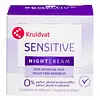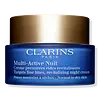What's inside
What's inside
 Key Ingredients
Key Ingredients

 Benefits
Benefits

 Concerns
Concerns

 Ingredients Side-by-side
Ingredients Side-by-side

Water
Skin ConditioningCaprylic/Capric Triglyceride
MaskingGlycerin
HumectantCetearyl Alcohol
EmollientPlukenetia Volubilis Seed Oil
EmollientSodium Polyacrylate
AbsorbentButyrospermum Parkii Butter
Skin ConditioningPhragmites Communis Extract
Skin ConditioningPoria Cocos Extract
Skin ConditioningTocopheryl Acetate
AntioxidantSodium Stearoyl Glutamate
CleansingCaprylyl Glycol
EmollientEthylhexylglycerin
Skin ConditioningTetrasodium Glutamate Diacetate
Phenoxyethanol
PreservativeSodium Benzoate
MaskingTocopherol
AntioxidantWater, Caprylic/Capric Triglyceride, Glycerin, Cetearyl Alcohol, Plukenetia Volubilis Seed Oil, Sodium Polyacrylate, Butyrospermum Parkii Butter, Phragmites Communis Extract, Poria Cocos Extract, Tocopheryl Acetate, Sodium Stearoyl Glutamate, Caprylyl Glycol, Ethylhexylglycerin, Tetrasodium Glutamate Diacetate, Phenoxyethanol, Sodium Benzoate, Tocopherol
Water
Skin ConditioningCetearyl Isononanoate
EmollientGlycerin
HumectantIsononyl Isononanoate
EmollientPropanediol
SolventCetearyl Alcohol
EmollientSucrose Polystearate
EmollientButyrospermum Parkii Butter
Skin ConditioningCetearyl Glucoside
EmulsifyingSodium Stearoyl Glutamate
CleansingParfum
MaskingCellulose
AbsorbentCetyl Palmitate
EmollientDipsacus Sylvestris Extract
Skin ConditioningCaprylyl Glycol
EmollientCarbomer
Emulsion StabilisingEthylhexylglycerin
Skin ConditioningTocopheryl Acetate
AntioxidantDisodium EDTA
Sodium Hyaluronate
HumectantActinidia Chinensis Fruit Extract
EmollientButylene Glycol
HumectantMarrubium Vulgare Extract
Skin ConditioningHedychium Coronarium Root Extract
MaskingPhenethyl Alcohol
MaskingFurcellaria Lumbricalis Extract
Skin ConditioningSodium Citrate
BufferingCitric Acid
BufferingLactic Acid/Glycolic Acid Copolymer
Skin ConditioningLapsana Communis Flower/Leaf/Stem Extract
Skin ConditioningMaris Sal
Skin ConditioningHeptapeptide-15 Palmitate
Skin ConditioningPolyvinyl Alcohol
Copper Palmitoyl Heptapeptide-14
Skin ConditioningWater, Cetearyl Isononanoate, Glycerin, Isononyl Isononanoate, Propanediol, Cetearyl Alcohol, Sucrose Polystearate, Butyrospermum Parkii Butter, Cetearyl Glucoside, Sodium Stearoyl Glutamate, Parfum, Cellulose, Cetyl Palmitate, Dipsacus Sylvestris Extract, Caprylyl Glycol, Carbomer, Ethylhexylglycerin, Tocopheryl Acetate, Disodium EDTA, Sodium Hyaluronate, Actinidia Chinensis Fruit Extract, Butylene Glycol, Marrubium Vulgare Extract, Hedychium Coronarium Root Extract, Phenethyl Alcohol, Furcellaria Lumbricalis Extract, Sodium Citrate, Citric Acid, Lactic Acid/Glycolic Acid Copolymer, Lapsana Communis Flower/Leaf/Stem Extract, Maris Sal, Heptapeptide-15 Palmitate, Polyvinyl Alcohol, Copper Palmitoyl Heptapeptide-14
 Reviews
Reviews

Ingredients Explained
These ingredients are found in both products.
Ingredients higher up in an ingredient list are typically present in a larger amount.
This ingredient is also known as shea butter. It is an effective skin hydrator and emollient.
Emollients help soothe and soften your skin. It does this by creating a protective film on your skin. This barrier helps trap moisture and keeps your skin hydrated. Emollients may be effective at treating dry or itchy skin.
Shea butter is rich in antioxidants. Antioxidants help fight free-radicals, or molecules that may harm the body. It is also full of fatty acids including stearic acid and linoleic acid. These acids help replenish the skin and keep skin moisturized.
While Shea Butter has an SPF rating of about 3-4, it is not a sunscreen replacement.
Shea butter may not be fungal acne safe. We recommend speaking with a professional if you have any concerns.
Learn more about Butyrospermum Parkii ButterCaprylyl Glycol is a humectant and emollient, meaning it attracts and preserves moisture.
It is a common ingredient in many products, especially those designed to hydrate skin. The primary benefits are retaining moisture, skin softening, and promoting a healthy skin barrier.
Though Caprylyl Glycol is an alcohol derived from fatty acids, it is not the kind that can dry out skin.
This ingredient is also used as a preservative to extend the life of products. It has slight antimicrobial properties.
Learn more about Caprylyl GlycolCetearyl alcohol is a mixture of two fatty alcohols: cetyl alcohol and stearyl alcohol. It is mainly used as an emulsifier. Emulsifiers help prevent the separation of oils and products. Due to its composition, it can also be used to thicken a product or help create foam.
Cetearyl alcohol is an emollient. Emollients help soothe and hydrate the skin by trapping moisture.
Studies show Cetearyl alcohol is non-toxic and non-irritating. The FDA allows products labeled "alcohol-free" to have fatty alcohols.
This ingredient is usually derived from plant oils such as palm, vegetable, or coconut oils. There is debate on whether this ingredient will cause acne.
Due to the fatty acid base, this ingredient may not be Malassezia folliculitis safe.
Learn more about Cetearyl AlcoholEthylhexylglycerin (we can't pronounce this either) is commonly used as a preservative and skin softener. It is derived from glyceryl.
You might see Ethylhexylglycerin often paired with other preservatives such as phenoxyethanol. Ethylhexylglycerin has been found to increase the effectiveness of these other preservatives.
Glycerin is already naturally found in your skin. It helps moisturize and protect your skin.
A study from 2016 found glycerin to be more effective as a humectant than AHAs and hyaluronic acid.
As a humectant, it helps the skin stay hydrated by pulling moisture to your skin. The low molecular weight of glycerin allows it to pull moisture into the deeper layers of your skin.
Hydrated skin improves your skin barrier; Your skin barrier helps protect against irritants and bacteria.
Glycerin has also been found to have antimicrobial and antiviral properties. Due to these properties, glycerin is often used in wound and burn treatments.
In cosmetics, glycerin is usually derived from plants such as soybean or palm. However, it can also be sourced from animals, such as tallow or animal fat.
This ingredient is organic, colorless, odorless, and non-toxic.
Glycerin is the name for this ingredient in American English. British English uses Glycerol/Glycerine.
Learn more about GlycerinSodium Stearoyl Glutamate is an emulsifier and helps condition the skin. It is amino acid-based.
In higher amounts, it may act as a cleansing agent.
Tocopheryl Acetate is AKA Vitamin E. It is an antioxidant and protects your skin from free radicals. Free radicals damage the skin by breaking down collagen.
One study found using Tocopheryl Acetate with Vitamin C decreased the number of sunburned cells.
Tocopheryl Acetate is commonly found in both skincare and dietary supplements.
Learn more about Tocopheryl AcetateWater. It's the most common cosmetic ingredient of all. You'll usually see it at the top of ingredient lists, meaning that it makes up the largest part of the product.
So why is it so popular? Water most often acts as a solvent - this means that it helps dissolve other ingredients into the formulation.
You'll also recognize water as that liquid we all need to stay alive. If you see this, drink a glass of water. Stay hydrated!
Learn more about Water